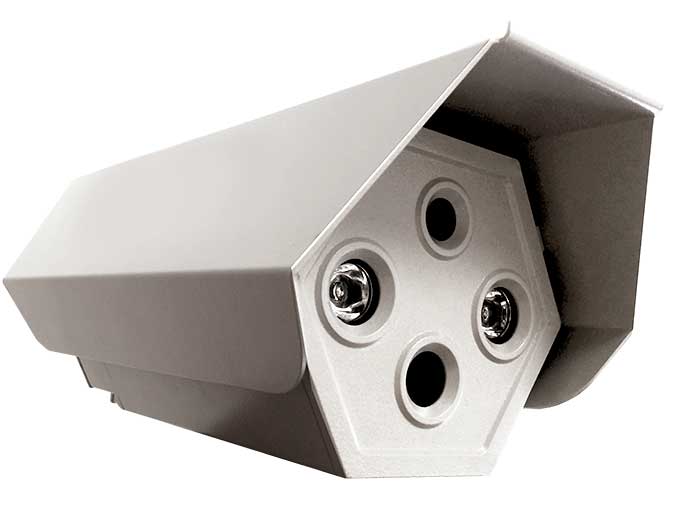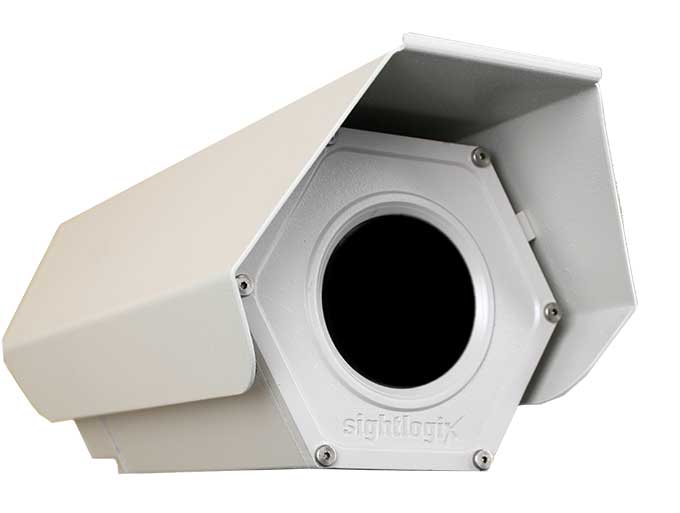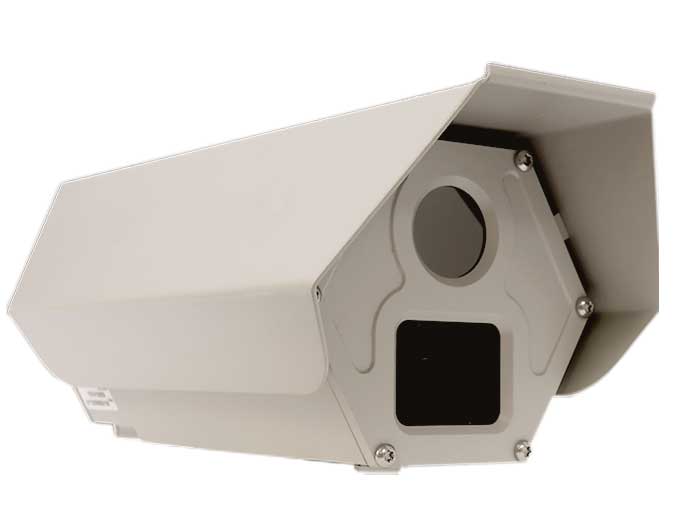- August 24, 2021
- Posted by: Eric Heller
- Category: Blog
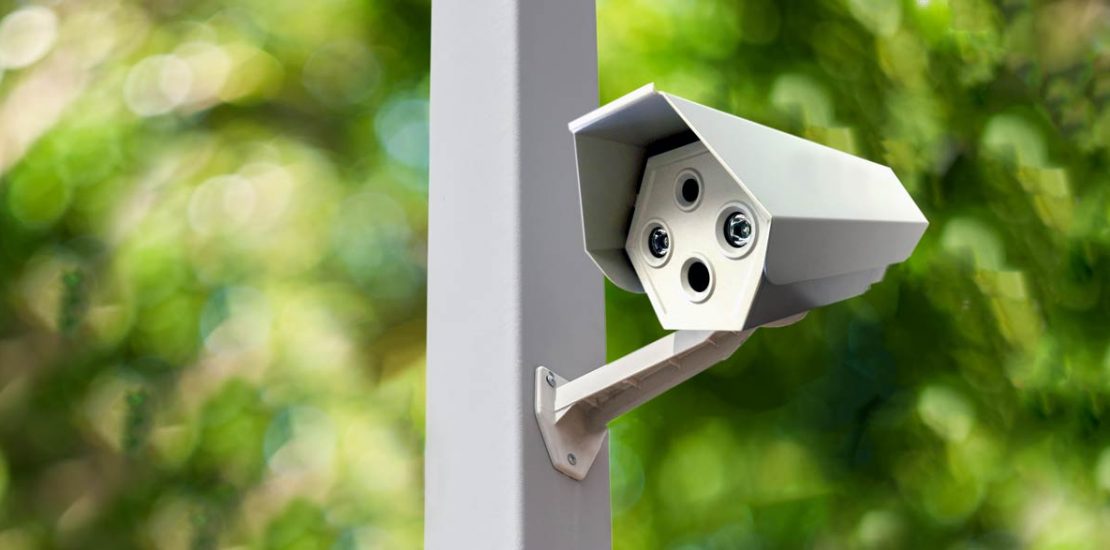
Thermal Security Cameras “See” Heat
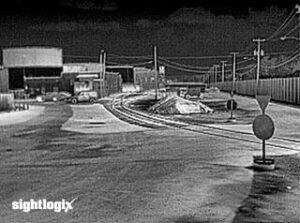 Our eyes work by seeing contrast between objects that are illuminated by either the sun or another form of light. Thermal security cameras work by “seeing” heat energy from objects. All objects – living or not – have heat energy that infrared cameras use to create an image.
Our eyes work by seeing contrast between objects that are illuminated by either the sun or another form of light. Thermal security cameras work by “seeing” heat energy from objects. All objects – living or not – have heat energy that infrared cameras use to create an image.
Because they act like a heat vision camera rather than one which uses reflected light, thermal images look very different than what’s seen by a visible camera or the eye. In order to present heat in a format appropriate for human vision, thermal cameras convert the infrared information into an image that shows the surface temperature of the object being measured. With each temperature being assigned a different color or gray shade, this produces a gradient map.
On a cold day a person stands out as lighter because they are hotter than the background. On a hot day a person stands out as darker because they are cooler than the background.
Thermal cameras have long been a good choice for “seeing in the dark” because at night background objects tend to be cooler than a person at 98.6 degrees. Under ideal conditions, people are well emphasized at night because they appear brighter than the background and stand out, even in zero light. This makes thermal cameras a useful tool for detecting the presence of people in situations when they might be invisible to the human eye.
How are Thermal Cameras Used for Security?
Originally, thermal cameras were used mostly for military operations due to their expense. Now that thermal imagers have become commercially viable, and given their ability to see through darkness and bad weather, it’s no surprise that security professionals have embraced them as ideal “people detectors.” When properly equipped, they can automatically detect intruders attempting to breach outdoor perimeters with high reliability even in an unpredictable outdoor environment.
The key to this capability lies in thermal video processing.
Thermal imaging cameras can see fine temperature variations representing thousands of shades of gray, far beyond the capability of human vision. In most cases, thermal cameras convert this information into about 250 gray scales to reduce bandwidth, limit video processing requirements, and more closely match what our eyes can see. As a result, many thermal cameras actually remove a large of amount of critical scene information when delivering video to the network.
While this can help with “seeing in the dark”, it creates significant drawbacks for security applications, which require the best information to reliably detect a person in the always-changing outdoors.
At SightLogix, our approach is to create a wide dynamic range thermal image which uses thousands of shades of gray and does not remove critical scene information. More information directly corresponds to better security, because the camera can see more objects, over larger areas, with greater accuracy. We always have two concepts in mind – deliver the most detailed thermal imagery for our video analytics to detect intruders and provide the best-looking thermal video for people to assess the scene.
The image below illustrates the challenge. The top row shows six levels of gray which the eye can see. The bottom row shows sixteen shades of gray – you can see how it is starting to become difficult to tell where the shades transition from one block to the next.

Since a thermal imager senses 1,000 times more shades of gray than shown in the lower bar graph, most thermal cameras convert these thousands of shades that exceed human vision in a simplistic way, mapping gross areas together that are close in temperature. This is why thermal images often look blurry, lack detail, and can miss intruders.
A better way to perform this conversion would be to emphasize the small variations between objects and the background to exaggerate the fine details, in contrast to other image features, to improve quality and deliver a wide-dynamic thermal picture.
This is a highly processing-intensive task. A thermal camera must process many millions of bits of data every second, day and night, in order to create a quality, high-contrast image needed for security applications. Only cameras with very powerful image processing are up to the task.
The Role of Video Processing to Enhance Thermal Security Camera Performance
Since our inception, SightLogix has always maintained that video processing – at the edge, inside the camera – is a foundational requirement for turning thermal cameras into reliable intruder detectors. SightSensor thermal cameras are engineered with significant processing capabilities to provide a high-clarity image even in low-contrast outdoor situations, earning their reputation for detection performance.
The image below shows the difference between typical thermal cameras (at left) and SightLogix cameras with high-quality processing (at right). In this scene, taken during a heavy storm, the drenching rain has brought all objects very close to a uniform temperature.
The left capture shows a camera which lacks the processing to create good contrast images in this common situation. On the right, the same video has been intelligently remapped by the SightSensor’s image processing to emphasize the small temperature differences in the hotter objects, presenting an image that can better reveal potential intruders.
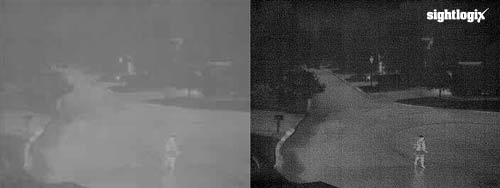
Combining Thermal Cameras with Video Analytics for Reliable Intrusion Detection
Once a thermal camera can produce a quality, high-contrast image, the next step is to automate the detection with video analytic software. Video analytics is used to automatically analyze the live video for the presence of unauthorized activity, and alert security personnel to take action. When an intruder breaks a video analytic rule, the software delivers a red box with real-time alarms the instant an intruder enters an unauthorized space (check out video examples of a smart thermal camera in action).
This is what turns thermal cameras into “smart” devices that extend the capability of people. Smart cameras never tire, can see in the dark or bright sun, and can be relied on to detect intruders in all weather, all the time.
Video processing plays an important role here as well. In addition to enhancing the quality of the image, SightSensors embed their analytic software directly into the high-processing camera environment. This lets the software analyze the full dynamic range of a highly optimized thermal image, with over 1,000 times the detail than other thermal cameras can achieve.
The result is a highly reliable intruder detector solution for the toughest outdoor conditions.
View our video:
Combing Thermal Cameras with Video Analytics for Reliable Intrusion Detection
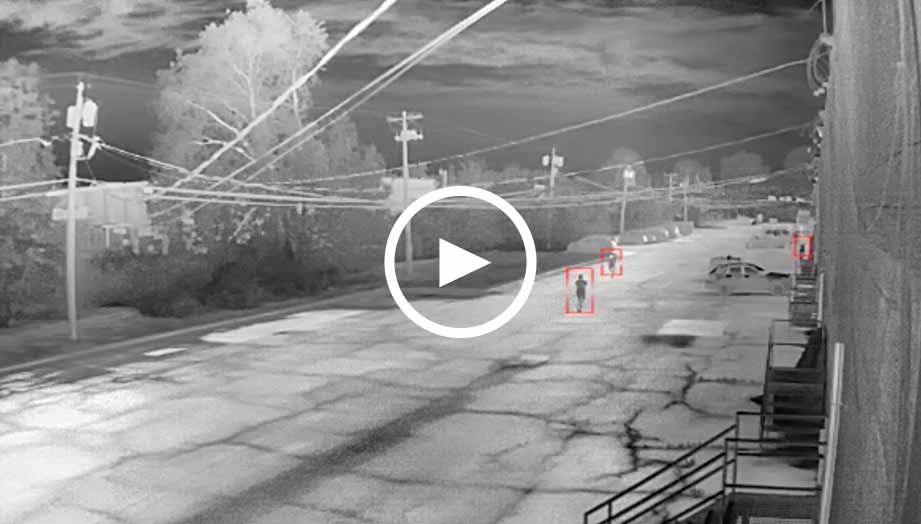
This approach of combing onboard video analytics, wide-dynamic range thermal video, and powerful video processing delivers a range of security benefits, including:
- Excellent 24/7 detection performance in all conditions, with early warning over large buffers zones spanning hundreds of meters
- An ability to acquire an intruder’s speed, bearing, and geo-location in milliseconds
- One-click Geospatial Zones – not tripwires – based on size, speed, bearing, and geo-location that greatly reduces false alarms from small animals, blowing trash
- Built-in Automatic Stabilization that removes false alarms due to camera shake from wind and vibrations
- An ability to automatically spin PTZs to zoom and follow a detected target for real-time assessment
- Dual-Video analytics that detect on both thermal and visible sensors simultaneously to reduce nuisance alerts and increase intruder detection reliability
- A proven solution that delivers security peace of mind


